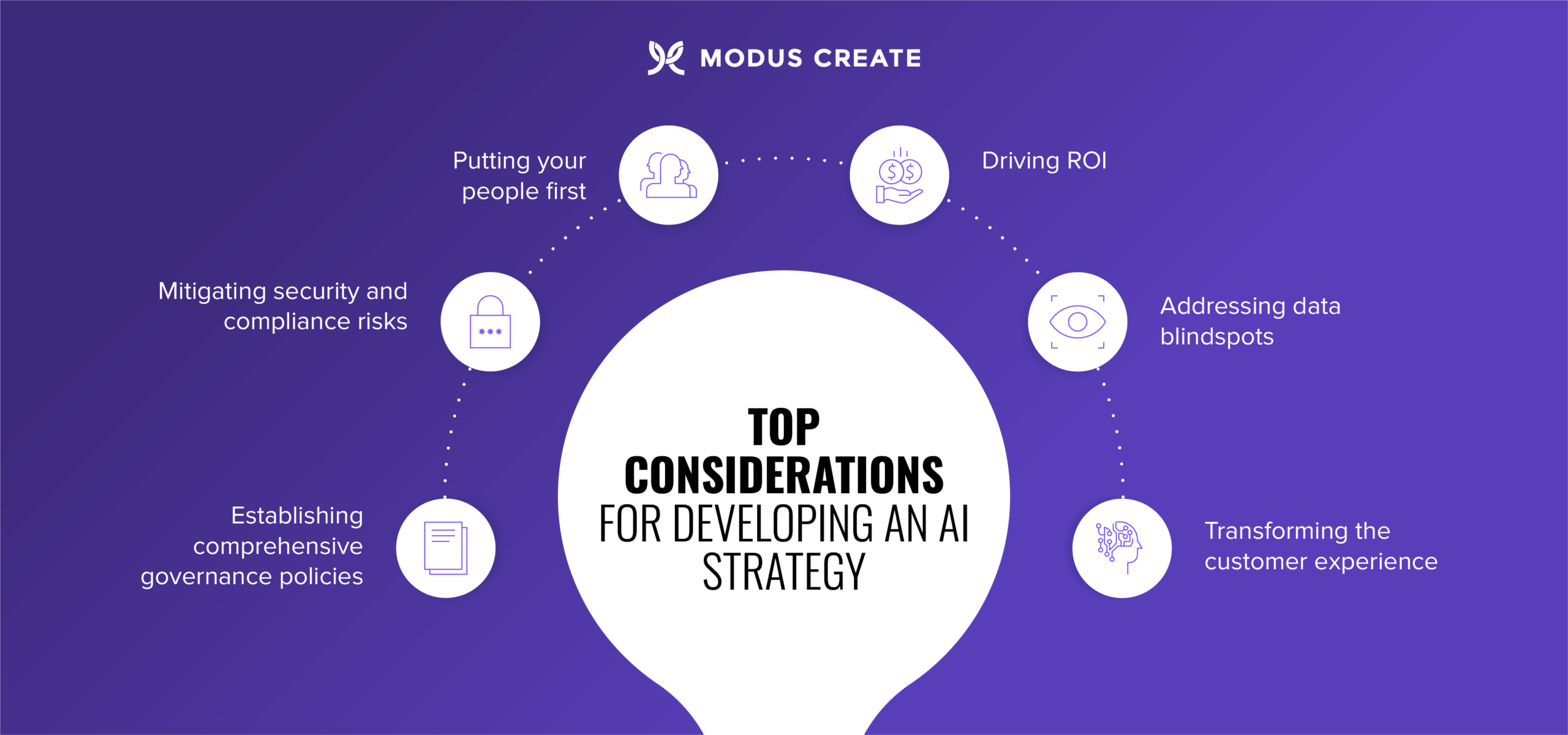Breaking through the hype: a practical guide to building an effective AI strategy


Table of contents
Subscribe via Email
Subscribe to our blog to get insights sent directly to your inbox.
There’s a ton of hype around AI, with widespread talk about its potential to transform every aspect of business. However, while every exec knows they need to invest in AI, most grapple with questions like, “Where do I begin?”
Ensuring that AI adds value to your organization requires an AI strategy. Like many AI transformation initiatives, this means shifting the conversation from “How soon can we start?” to “What should we consider?”
As Modus Create CEO Pat Sheridan succinctly puts it in his article on the top digital initiatives keeping executives up at night, “As enterprise leaders, we need to figure out how AI augments and supports overall digital initiatives before blindly investing.”
With that in mind, I’m pulling back the curtain with a practical look at how to:
- analyze your organization’s readiness for AI
- identify your AI priorities
- create a roadmap to guide your company through the complexities of building an effective AI adoption strategy

Assessing your strategic AI adoption priorities
Finding a starting point involves assessing how an AI strategy fits into your existing digital strategy. In our 2024 research report, 39% of enterprises cited AI as a top initiative, more than any other initiative.
Interestingly, smaller companies cited AI as a greater focus area than their larger counterparts with 10,000+ employees, which were more heavily focused on initiatives like cloud migration, user experience, and modernizing their customer-facing products. Just 22% of companies with 10,000+ employees cited AI/RPA as a core focus.
This is likely because larger enterprises are taking a “go-slow” approach, given AI’s security risks and ethical concerns. Larry Fitzpatrick, Executive Vice President and CTO of OneMain Financial, the leading nonprime lender in the United States, provides insight into how the world’s top executives plan to leverage AI technology.
In our Conversations with Chief Innovators series, Larry explains that business leaders are concerned about AI because it “exhibits behaviors we might label as bad in humans.” As a result, he says, “We need to understand and quantify the risk profile of new solutions using generative AI.”
There’s no doubt that a comprehensive AI strategy is critical. But what does building one look like for your business?
Top considerations for developing an AI strategy
AI strategies are not one-size-fits-all—yours should be tailored to organizational needs and strategic business goals. We’ve defined the most critical considerations as you navigate AI’s complexity and start to take advantage of its capabilities.
Mitigating security and compliance risks
Managing your AI cybersecurity risk should come first when building your AI strategy.
Consider this eye-opening stat: PWC reports that 60% of organizations have experienced security incidents related to AI or machine learning.
As my colleague William Reyor, Modus Create Director of Security, explains in an article on AI risk, “As organizations increasingly rely on AI and other advanced technologies, the risks associated with data breaches, cyberattacks, and unauthorized access have become more significant. Strong cybersecurity measures are necessary to protect sensitive information and comply with various regulations and industry standards.“
Rather than wait until the last minute, business leaders should act now. Security is a do-not-pass-go step so your organization can effectively protect sensitive information and make security part of your culture. The risk of fines, sanctions, and reputational damage is simply too costly to ignore the issue.
Rob Lee, Chief of Research and Head of Faculty at SANS Institute, sums it up well: “Treat AI and cybersecurity like a workout. This will increase your lifespan. If you want your organization to last...you must view this as a daily habit and keep learning and staying on top of the latest trends.”
Action Step: Assess your AI cybersecurity risk and ensure your policies are up-to-date, including proper training on security best practices for your employees.
AI initiatives are not one-size-fits-all—yours should be tailored to organizational needs and strategic goals. We’ve defined the most critical considerations as you navigate AI’s complexity and start to take advantage of its capabilities.
The importance of AI governance
When AI strategy implementation is rushed, governance can sometimes be an afterthought. This is a huge oversight that can put you at risk. Governance is the cornerstone, setting the organizational rules and norms and aligning AI with your mission and values to realize efficiencies without overstepping boundaries.
Tech leaders like Brad Smith, Vice Chair & President of Microsoft, are weighing in on the importance of governance in AI. As Brad says, “As technological change accelerates, the work to govern AI responsibly must keep pace with it.”
IBM is also taking AI governance seriously, announcing its efforts to partner with Amazon Web Services (AWS) to help clients responsibly scale AI.
A critical part of building your AI strategy should include developing comprehensive policies that help mitigate compliance risks, cover ethical considerations, and define how your organization and employees can use AI.
Action Step: Determine why you’re adopting AI and create policies around acceptable usage within your organization.
Data blindspots hinder your AI strategy
To get the most out of AI, it must be tuned to your specific needs and knowledge, embedded in your data. Yet, numerous companies grappling with AI strategy implementation often encounter setbacks or outright failures attributable to data-related issues. These challenges manifest in various forms, from poor data quality and reliability to inaccessible data sources, stemming from disparate systems and a lack of governance.
The numbers speak for themselves: According to a survey of 500 data professionals by the open source data quality tool Great Expectations, 91% report that poor data quality impacts their company’s performance.
When data is hard to find, access, understand, or trust, it blocks any AI initiative. On the other hand, successful AI projects are often the result of a healthy company-wide data ecosystem.
To overcome these hurdles, laying out the right data infrastructure and governance is key to unlocking AI potential.
Action Step: Catalogize data sources, assess their quality, set up a data governance framework, and ensure data is accessible to the right people.
Starting small with a strategic POC
AI-powered initiatives like intelligent apps have the potential to transform your business by delivering personalized, adaptive, and data-driven user experiences to customers. However, their experimental nature can be risky and require a lot of resources to get right.
To ensure high-risk, high-reward AI initiatives drive value for your business, start with a proof of concept (PoC). A well-planned PoC enables your organization to test, validate, and refine AI initiatives before full-scale deployment, minimizing financial and operational risks and instilling confidence in key stakeholders along the way.
Action step: Create a winning POC that defines success metrics for a specific, high-impact use case.
Transforming the customer experience
In all the excitement about AI and its capabilities, it’s easy to focus on efficiency and productivity, overlooking AI’s effect on customer experience. But the most successful organizations keep customers at the center of their AI strategy.
This is important as your organization incorporates AI into digital products to create a smarter, more intuitive UX that meets customers’ expectations. By bringing it early into the concept phase, you can ensure AI is fully integrated with your product instead of being a minimally functional afterthought.
Action Step: Speak with your data and UX team to evaluate how your customers interact with your products, which will help you understand how AI can improve their experience.
Your people are your biggest strategic asset
As I’ve written about before, people are the most critical factor in digital transformation.
Your employees may resist AI strategy implementation, fearing their jobs—or entire departments—will become obsolete. While a percentage of the workforce might fall to a reduction in force, the World Economic Forum forecasts the creation of 97 million jobs due to AI. AI can be a tool to increase employee productivity, cutting out tedious, repetitive tasks in favor of more strategic projects.
Larry Fitzpatrick says it best in his conversation with Pat: “Nobody…is deploying generative AI directly to customers without human oversight.”
Like with many digital transformation initiatives, the challenge is how to communicate clearly and engage employees. When building an AI strategy, it’s crucial to document the outcomes and benefits for employees. Part of this is designating a change agent — an executive leader who will execute, manage, and communicate the rollout of changes throughout your company.
This is especially helpful when it comes to the developer experience. According to the 2024 Stack Overflow Developer survey, 80% of developers report being unhappy at work, with 1 in 3 saying they hate their jobs. This strong sentiment is difficult to ignore.
In cases like these, business leaders would benefit from explaining all the ways AI-powered tools like GitHub Copilot and GitHub Advanced Security can handle tedious tasks and streamline workflows, reducing cognitive overload and preventing burnout for engineering teams.
Action Step: Have a change agent develop communications and messaging about AI in your organization to educate employees and set expectations.
Driving ROI with your AI strategy
ROI tracking of GenAI investments is complex, as Gartner VP Analyst Rita Sallam reminds us, writing that organizations will get the most out of the latest innovations if they “build a business case by simulating potential cost and value realization across a range of GenAI activities.”
Among the activities that Sallam identifies are:
- quick wins that focus on productivity improvements
- differentiating initiatives that provide a competitive advantage
- more transformative initiatives where “innovators may have to accept difficult-to-quantify hard financial returns and higher cost, complexity and risk in exchange for first-mover advantage.”
At Gartner’s Tech Growth & Innovation Conference, fascinating insights were shared about the IT spending breakdown and ROI expectations. For example, 67% of GMs predict they will see a slight increase in revenue by incorporating GenAI into existing solutions or creating add-ons, versus POCs and developing and selling separate GenAI solutions, which aren’t expected to yield as much return.
Ultimately, your AI strategy can drive growth, but in some cases, cost and complexity may overshadow quick returns. It’s best to determine which investments will enable you to compete and start there.
Action Step: Identify where to invest in AI and create a realistic plan for tracking success and impact within your organization.
What can industry leaders teach us about AI?
You may be thinking: How are companies innovating with AI today?
While it’s true that many organizations still struggle to move beyond the excitement of AI’s potential and translate it into tangible business outcomes, several business leaders are making a positive impact.
For example, EVERSANA, a leading provider of commercial services to the life sciences industry, recently announced EVERSANA ORCHESTRATE™ MLR, an AI-powered platform built in collaboration with Modus and our partner AWS, and it’s a game-changer.
Most life science organizations have a manual Medical, Legal, and Regulatory (MLR) process, requiring teams to comb through hundreds of marketing materials and cross-reference them with the most accurate regulatory claims information available.
EVERSANA ORCHESTRATE™ MLR automates 90% of common tasks in the complex MLR process through a single platform that’s easy to implement and complies with all regulatory requirements.
By harnessing the power of Amazon Bedrock, the platform will empower life sciences companies with the AI tools they need to mitigate a significant pain point for the healthcare industry— administrative burden.
EVERSANA ORCHESTRATE™ MLR has been proven to deliver precise, consistent, and high-quality materials for MLR review with an 86% reduction in submission errors. Through automation, the MLR process is scalable and less resource-intensive, resulting in a 50% reduction in content reviews and an estimated 35% cost savings.
Abid Rahman, Senior Vice President, Innovation at EVERSANA, spoke about the new solution in a recent webinar with Modus Create and IDC:
Managing expectations for successful AI transformation
Building a successful AI strategy that positively impacts your organization hinges on setting realistic expectations. AI is a powerful tool, but it’s only a tool and one that requires thoughtful adoption and ongoing management as its capabilities evolve.
AI will impact nearly every industry. Taking the time today to create an effective AI strategy roadmap is the best way to position your company to thrive tomorrow.

Sarah McCasland is Chief Strategy Officer at Modus Create. Her core focuses are on scaling company growth through M&A, new offerings and go-to-market for clients, and designing and implementing modern organizational business architectures for internal and external success. She brings over fifteen years of experience supporting and leading companies through their digital transformation journeys, utilizing interactive approaches and operational business alignment.
Related Posts
Discover more insights from our blog.


